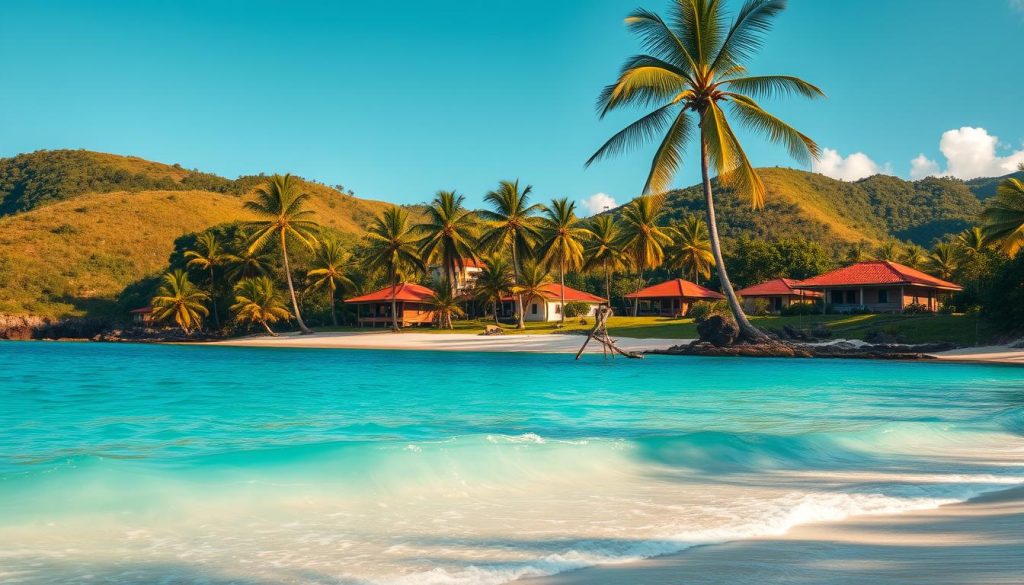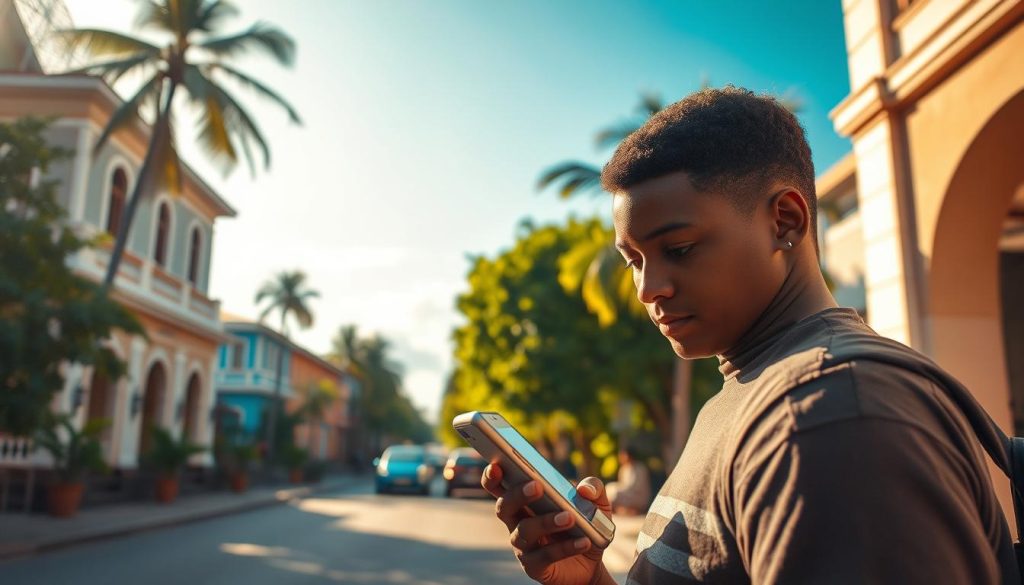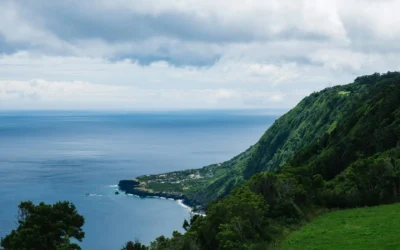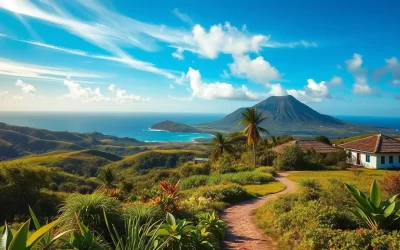✓ Accommodations✓ Flights✓ Rental Cars✓ Tours & Activities
Did you know that Mayotte, a small island in the Indian Ocean, uses the Euro as its official currency? This French overseas department offers a unique blend of French sophistication and local island charm, making it a fascinating destination for explorers.
When planning your trip, understanding the currency and payment methods is essential. The Euro is widely accepted, and you’ll find ATMs in key areas like Mamoudzou. This guide will help you navigate everything from local banking to budgeting tips, ensuring a smooth experience.
Whether you’re exploring the vibrant markets or relaxing on pristine beaches, knowing how to handle your money will make your journey even more enjoyable. Let’s dive into the details to help you prepare for an unforgettable adventure on this stunning island.
Introduction to Mayotte and Its Unique Travel Experience
Nestled in the Indian Ocean, Mayotte offers a unique blend of natural beauty and cultural richness. This island, shaped like a seahorse, is surrounded by one of the largest lagoons in the world, making it a destination unlike any other. Whether you’re drawn to its sandy beaches or lush countryside, Mayotte promises an unforgettable adventure.
Discovering Mayotte’s Natural Beauty and Culture
Mayotte’s geography is as fascinating as its culture. The island’s volcanic origins have created a landscape filled with rolling hills and vibrant coral reefs. Its lagoon, spanning over 1,500 square kilometers, is home to hundreds of marine species, perfect for snorkeling or diving.
The blend of French influence and local traditions gives Mayotte a distinctive charm. You’ll find French bakeries alongside bustling markets filled with handmade crafts and fresh produce. This mix of cultures makes every visit a unique experience.
Setting Your Expectations for Island Travel
Traveling to an island in the Indian Ocean requires some preparation. Mayotte’s transportation options include inter-island barges connecting Grande Terre and Petite Terre, making it easy to explore both regions. While the island’s infrastructure is developing, the sense of adventure is part of the appeal.
Expect a slower pace of life and a warm welcome from the locals. Whether you’re hiking through the countryside or relaxing on a pristine beach, Mayotte offers a chance to disconnect and immerse yourself in its natural beauty.
Currency Overview in Mayotte
The Euro is the lifeblood of daily transactions in this French overseas department. As the official currency, it simplifies financial matters for both locals and visitors. Whether you’re shopping at a bustling market or dining at a seaside café, the Euro is universally accepted.

The Role of the Euro (€) in Daily Transactions
In this island paradise, the Euro is more than just a currency—it’s a way of life. From paying for a cup of coffee to booking a boat tour, the Euro is your go-to for all transactions. French banks in downtown Mamoudzou offer ATMs, making it easy to withdraw money when needed.
Locals rely heavily on cash for daily expenses, but credit cards are gaining traction in tourist areas. If you’re planning to explore the island’s hidden gems, carrying some cash is advisable. Pro tip: Check exchange rates before your trip to ensure you get the best value.
Understanding Currency Subdivisions and Local Usage
The Euro is divided into cents, with coins and banknotes similar to those used in metropolitan France. Here’s a quick breakdown of common denominations:
| Type | Denominations |
|---|---|
| Coins | 1c, 2c, 5c, 10c, 20c, 50c, €1, €2 |
| Banknotes | €5, €10, €20, €50, €100, €200 |
While the currency system is straightforward, local practices may differ slightly. For instance, smaller vendors might prefer exact change, especially in rural areas.
“Carrying small denominations can make transactions smoother,”
advises a local shop owner.
Understanding these nuances will help you manage your money efficiently during your stay. Whether you’re strolling through the capital or relaxing by a serene lake, the Euro ensures a hassle-free experience.
Paying in Mayotte: Payment Methods and Options
When visiting Mayotte, understanding the payment methods available can make your trip smoother and more enjoyable. The island offers a mix of traditional and modern options, so knowing what to expect is key.
Cash, Cheques, and Credit Card Considerations
Cash is the most widely accepted way to pay in Mayotte. Many small vendors and rural areas prefer it, so carrying Euros is a smart option. ATMs are available in larger towns like Mamoudzou, but it’s best to withdraw cash before heading to remote areas.
Cheques from French banks are another accepted method, though they’re less common for tourists. This service is mostly used by locals for larger transactions. If you’re staying long-term, opening a local bank account might be worth considering.
Credit cards are gaining traction, especially in tourist areas. However, not every establishment accepts them. Major hotels, restaurants, and car rental agencies usually do, but smaller shops and markets often don’t. Always ask before assuming a card is accepted.
| Payment Method | Pros | Cons |
|---|---|---|
| Cash | Widely accepted, no fees | Risk of theft, need to carry exact change |
| Cheques | Secure for large transactions | Limited acceptance, requires a French bank account |
| Credit Cards | Convenient, offers rewards | Not accepted everywhere, potential fees |
To ensure safety, keep your cash and cards secure. Use a money belt or a secure bag, especially in crowded areas. Notify your bank of your travel plans to avoid issues with card transactions.
“Always carry some cash for smaller purchases, but keep it in a safe place,” advises a local shop owner.
By planning ahead and understanding the payment landscape, you can enjoy a hassle-free experience while exploring this beautiful island.
Mayotte: Ultimate Travelers Guide to Currencies & Payments
Handling money efficiently is crucial for a stress-free trip to any destination. In Mayotte, understanding the local currency and payment methods can save you time and effort. Here are some key insights to help you manage your finances smoothly during your stay.
Planning Ahead for Payment Methods
Before you arrive, it’s essential to plan how you’ll handle your money. Cash is the most widely accepted option, especially in rural areas. ATMs are available in larger towns like Mamoudzou, but it’s wise to withdraw cash before heading to remote spots.
Credit cards are gaining popularity in tourist areas, but not all establishments accept them. Always ask before assuming a card is accepted. For larger transactions, cheques from French banks are an option, though this is less common for tourists.
Real-World Tips from Travelers
Many travelers recommend carrying small denominations of cash for smoother transactions. Smaller vendors often prefer exact change, especially in markets or rural areas. One traveler shared,
“Having small bills made it easier to pay for local goods without any hassle.”
It’s also a good idea to notify your bank of your travel plans. This ensures your cards work without issues and helps avoid unexpected fees.
Secure Payment Practices
Safety is a priority when handling money abroad. Use a money belt or secure bag to keep your cash and cards safe, especially in crowded areas. Avoid displaying large amounts of cash in public to minimize the risk of theft.
For currency conversion, check exchange rates before your trip to get the best value. Many travelers find it helpful to carry a small calculator for quick conversions.
| Payment Method | Tips |
|---|---|
| Cash | Carry small denominations, withdraw before remote trips |
| Credit Cards | Ask before use, notify your bank |
| Cheques | Use for large transactions, requires French bank account |
By following these tips, you can ensure a hassle-free financial experience during your travel. Stay tuned for a deeper dive into cost breakdowns and real-life examples in the next section.
Cost of Living and Expense Breakdown
Exploring the cost of living in this island paradise can help you budget effectively for your trip. From a cup of coffee to a night’s stay, understanding daily expenses ensures you enjoy your time without financial stress.
Real-World Examples: Coffee, Meals, and Hotel Rates
Everyday items like coffee and meals can give you a sense of local prices. A cappuccino costs around €3, while a meal at an inexpensive restaurant averages €10. For a mid-range dining experience, expect to pay €30-€40 for two people.
Accommodation options vary widely. Budget Airbnb listings start at €50 per night, while mid-range hotels like the Maharajah Hotel charge €100-€150. These rates reflect the island’s higher cost of living compared to other destinations.
Comparing Prices Across Different Areas
Prices differ between urban and remote areas. In the capital, Mamoudzou, dining and lodging are more expensive. A meal in the city center can cost 20% more than in rural areas.
For those planning to explore the beach or the sea, remote locations often have fewer options but can be more affordable. However, transportation costs, like car rental, should be factored into your budget.
Here’s a quick comparison of typical expenses:
| Item | Urban Area | Remote Area |
|---|---|---|
| Cappuccino | €3.50 | €2.50 |
| Meal (Inexpensive) | €12 | €8 |
| Hotel (Mid-Range) | €150 | €100 |
Long-term stays require careful planning. Monthly rental costs for a one-bedroom apartment in the city center start at €800, while outside the capital, prices drop to €600. Utilities like water and electricity add €100-€150 per month.
“Budgeting for daily expenses and accommodation ensures a stress-free trip,” advises a frequent traveler.
By understanding these costs, you can plan your day-to-day expenses and enjoy the beauty of this country without breaking the bank.
Ensuring Payment Safety and Security
Staying safe while managing your money is a top priority for any trip. In some areas, crime rates can be higher, making it essential to take precautions. By following a few simple steps, you can protect your belongings and enjoy a worry-free experience.

Tips to Prevent Theft and Fraud
Always keep your cash and cards secure. Use a money belt or a hidden pouch to store your valuables. Avoid displaying large amounts of money in public, especially in crowded tourist areas.
Be aware of common scams. For example, some individuals may try to distract you while another person steals your belongings. Stay alert and trust your instincts if something feels off.
Advice on Handling Cash and Securing Your Belongings
Carry only the cash you need for the day. Leave extra money and important documents in a safe at your accommodation. This reduces the risk of losing everything if something happens.
When using a taxi, ensure it’s from a reputable company. Always check the driver’s identification and confirm the fare before starting your journey. This helps avoid overcharging or unsafe situations.
Choose secure accommodations. Look for places with good reviews and safety features like 24-hour security. This adds an extra layer of protection during your stay.
“Taking a few precautions can make a big difference in ensuring a safe trip,” advises a frequent traveler.
By following these tips, you can focus on enjoying your time on the island without worrying about your safety. Stay vigilant and prepared, and you’ll have a memorable and secure experience.
Local Banking and ATM Accessibility
Navigating banking services in a foreign destination can be straightforward with the right information. In this island paradise, ATMs and banks are concentrated in key areas, making it easy to manage your finances. However, understanding where to find these services and how to use them efficiently is essential for a smooth trip.
Where to Find ATMs and Banking Services
ATMs are widely available in the capital, Mamoudzou, and on Petite Terre. These locations are your best bet for withdrawing cash. Local banks, which follow French banking standards, offer reliable services for both locals and visitors.
In more remote areas, ATM availability becomes sparse. If you plan to explore the countryside or visit nearby beaches, it’s wise to withdraw cash beforehand. This ensures you’re prepared for any expenses along the way.
Tips for Secure and Cost-Effective Transactions
To avoid unnecessary fees, use ATMs affiliated with your bank or those within the Global ATM Alliance. This can save you on foreign transaction charges. Always notify your bank of your travel plans to prevent card issues.
For added security, keep your cash and cards in a safe place. Avoid displaying large amounts of money in public, especially in crowded areas. These simple steps can help protect your finances during your stay.
| Location | ATM Availability | Tips |
|---|---|---|
| Mamoudzou | High | Withdraw cash here before heading to remote areas. |
| Petite Terre | Moderate | Check the nearest ATM location before exploring. |
| Remote Areas | Low | Carry enough cash for your needs. |
While enjoying the stunning beaches or planning your next flight from the local airline hub, knowing where to access banking services can make your trip more convenient. By following these tips, you can focus on exploring the island without worrying about your finances.
Currency Exchange and Conversion Rates
Understanding currency exchange is a key part of planning any trip abroad. Exchange rates and fees can significantly impact your budget, so knowing how to navigate them is essential. This guide will help you make informed decisions and save money during your travel.

How to Navigate Exchange Rates and Fees
Exchange rates determine how much one currency is worth in another. As of March 2025, the Euro remains stable, but rates can fluctuate daily. Use online tools like XE or OANDA to check real-time rates. These platforms are free and provide accurate data.
When exchanging money, fees can add up quickly. Banks and credit card companies often charge foreign transaction fees, which can range from 1% to 3%. To minimize costs, consider using prepaid travel cards or services like Revolut, which offer competitive rates and lower fees.
Comparing Conversion Rates Across Institutions
Not all financial institutions offer the same rates. Traditional banks may have higher fees compared to online services. For example, TransferWise and Monito provide transparent fee structures and better rates. Always compare options before making a decision.
Here’s a quick comparison of popular services:
| Service | Fees | Exchange Rate |
|---|---|---|
| Traditional Banks | 1%-3% | Market Rate |
| TransferWise | 0.5%-1% | Better than Market |
| Revolut | 0%-1% | Best Available |
Planning Currency Exchanges as Part of Your Budget
Include currency exchange in your overall budgeting strategy. Avoid last-minute exchanges at airports or hotels, as they often have poor rates and high fees. Instead, plan ahead and use reliable services.
Carry a mix of cash and cards for flexibility. While cash is useful for small purchases, cards are safer for larger transactions. Notify your bank of your travel plans to avoid issues with card usage.
“Comparing rates and fees beforehand can save you a significant amount of money,” advises a frequent traveler.
By understanding exchange rates and fees, you can manage your finances efficiently. This ensures a stress-free and enjoyable way to explore your destination.
Economic Impact and Travel Budgeting
The economic dynamics of Mayotte play a significant role in shaping your travel budget. As France’s newest department, the island faces unique challenges and disparities that affect daily life and travel expenses. Understanding these factors can help you plan better and make the most of your trip.
Understanding Local Economic Disparities
Mayotte’s economy is shaped by its status as a French overseas department. While government funding has improved infrastructure, disparities remain. The capital, Mamoudzou, is more developed, but rural areas lag behind. This impacts pricing and availability of services.
Illegal immigration from neighboring countries also strains resources. This has led to higher costs in some sectors, such as healthcare and housing. Being aware of these disparities helps you set realistic expectations for your travel budget.
Setting a Realistic Budget
The cost of living in Mayotte is higher compared to nearby regions. For example, a meal in the capital can cost 20% more than in rural areas. Accommodation, especially near the beach, is also pricier. Here’s a quick comparison:
| Expense | Urban Area | Rural Area |
|---|---|---|
| Meal (Inexpensive) | €12 | €8 |
| Hotel (Mid-Range) | €150 | €100 |
| Car Rental (Per Day) | €50 | €40 |
For long-term stays, consider monthly rental costs. A one-bedroom apartment in the city center starts at €800, while outside the capital, prices drop to €600. Utilities like water and electricity add €100-€150 per month.
Tips for Managing Time and Money
Efficiently managing your time and money ensures a smoother trip. Start by prioritizing activities. For example, exploring the sea and beach can be more affordable than dining in high-end restaurants.
Use local transportation options to save on car rental costs. Barges between Grande Terre and Petite Terre are affordable and convenient. Plan your day to avoid unnecessary expenses.
“Budgeting for daily expenses and accommodation ensures a stress-free trip,” advises a frequent traveler.
By understanding Mayotte’s economic landscape, you can create a realistic budget and enjoy your travel without financial stress. Plan ahead, stay informed, and make the most of your time on this beautiful island.
Practical Money Handling Tips for a Hassle-Free Trip
Managing your money wisely while traveling can make your trip smoother and more enjoyable. From exchanging currency to withdrawing cash, a little planning goes a long way. Here are some practical tips to help you handle your finances efficiently during your journey.

Best Practices for Exchanging and Withdrawing Cash
When exchanging currency, avoid airport counters. They often have high fees and poor rates. Instead, use local banks or reliable online services like TransferWise or Revolut. These platforms offer competitive rates and lower fees, saving you money in the long run.
For cash withdrawals, choose ATMs affiliated with your bank or those within the Global ATM Alliance. This reduces foreign transaction fees. Always notify your bank of your travel plans to avoid card issues. Carrying small denominations of cash is also a smart option for smoother transactions.
Planning Ahead for Emergencies
Always have a backup plan for financial emergencies. Carry a mix of cash and cards for flexibility. Prepaid travel cards are a great way to manage your budget and avoid overspending. They also offer better exchange rates than cash exchanges.
For larger transactions, consider using cheques from French banks. While this is less common for tourists, it’s a secure service for significant expenses. Planning ahead ensures you’re prepared for any situation.
Using ATMs Effectively
ATMs are widely available in urban areas but sparse in remote locations. Withdraw cash before heading to rural spots to avoid inconvenience. Be mindful of fees, as some banks charge a percentage of the withdrawal amount. Using local currency instead of dynamic currency conversion (DCC) can save you 3-5% on fees.
| Financial Service | Pros | Cons |
|---|---|---|
| Local Banks | Reliable, lower fees | Limited hours, may require ID |
| Prepaid Travel Cards | Competitive rates, no foreign fees | Initial setup required |
| Online Services | Best rates, convenient | Requires internet access |
By following these tips, you can manage your finances efficiently and focus on enjoying your travel. Stay prepared, stay safe, and make the most of your time exploring new destinations.
Linking Currency Insights with Overall Travel Planning
Planning your finances effectively can transform your travel experience from stressful to seamless. By integrating currency handling with your itinerary, you can focus on enjoying your journey rather than worrying about money. This section provides practical tips to align your payment methods with your travel plans and ensure a smooth trip.
Aligning Payment Methods with Your Activities
Your travel itinerary plays a key role in determining how you manage your money. For example, if you plan to explore remote areas, carrying cash is essential. ATMs are sparse in rural regions, so withdrawing money in the capital or other urban centers is a smart move.
For activities like dining or shopping in tourist hotspots, credit cards are convenient. However, always confirm card acceptance beforehand. Smaller vendors and markets often prefer cash, especially in less developed areas. By aligning your payment methods with your plans, you can avoid unnecessary stress.
Strategies for Budgeting and Itinerary Planning
Budgeting is a crucial part of travel planning. Start by estimating daily expenses like meals, transportation, and accommodations. Allocate funds for activities such as snorkeling, hiking, or visiting cultural sites. This ensures you don’t overspend and can enjoy every moment of your trip.
Consider using prepaid travel cards for better exchange rates and lower fees. These cards are also safer than carrying large amounts of cash. Notify your bank of your travel dates to prevent card issues while abroad.
Leveraging Local Services for a Stress-Free Experience
Local services and facilities can make your trip more enjoyable. For instance, inter-island barges are an affordable way to explore different parts of the island. Many hotels and tour operators also offer payment plans or discounts for advance bookings.
Here’s a quick comparison of payment options and their benefits:
| Payment Method | Best For | Tips |
|---|---|---|
| Cash | Remote areas, small vendors | Carry small denominations for convenience |
| Credit Cards | Hotels, restaurants, car rentals | Confirm acceptance before use |
| Prepaid Travel Cards | Budgeting, safety | Load funds in advance for better rates |
By merging financial insights with logistical planning, you can create a seamless travel experience. Stay prepared, stay informed, and make the most of your time in this beautiful destination.
Additional Travel and Payment Insights for Mayotte
Exploring the hidden gems of Mayotte can elevate your travel experience to new heights. Beyond the well-known attractions, this main island offers secret spots and local insights that make your journey unforgettable. Here’s how to uncover the best of what Mayotte has to offer.
Insider Tips on Unexplored Beaches
Mayotte’s beach scene goes beyond the popular N’Gouja. Venture to hidden coves like Saziley Beach, where turquoise waters meet untouched shores. These spots are perfect for a quiet day of relaxation or snorkeling in crystal-clear water.
Local Diving and Water Activities
For diving enthusiasts, Mayotte’s coral reefs are a must-see. Local dive operators offer guided tours to explore vibrant marine life. If diving isn’t your thing, try kayaking or paddleboarding in the lagoon. These activities provide a unique way to experience the island’s natural beauty.
Unique Accommodation and Cultural Highlights
From eco-lodges to boutique guesthouses, Mayotte’s accommodation options cater to all tastes. Stay in a traditional bungalow near the beach for an authentic experience. Don’t miss the chance to visit local markets and interact with friendly persons who share their culture and crafts.
Blending Must-See Attractions with Hidden Gems
Balance your itinerary by combining popular sites with off-the-beaten-path discoveries. Start your day with a visit to Mamoudzou’s bustling market, then escape to a secluded beach for sunset. This approach ensures you experience the best of both worlds.
“Taking the time to explore hidden spots made my trip to Mayotte truly special,” shares a recent traveler.
Practical Tips for a Smooth Experience
Use local taxi services for convenient transportation. Many drivers are knowledgeable about the island’s hidden gems. If you’re planning to explore remote areas, consider hiring a company for guided tours. This ensures you don’t miss out on the best experiences.
By blending well-known attractions with local secrets, you’ll create a travel experience that’s both enriching and memorable. Mayotte’s charm lies in its ability to surprise and delight, making it a country worth exploring in depth.
Conclusion
Exploring both popular and hidden spots can make your journey unforgettable. This guide has covered everything from understanding local currency to practical safety tips, ensuring you’re well-prepared for your adventure. Proper budgeting and money handling are key to a smooth experience, whether you’re dining in the capital or relaxing on a secluded beach.
Don’t miss the chance to explore the main island’s unique blend of culture and natural beauty. From vibrant markets to serene lagoons, every event and activity adds to the charm of this destination. Plan your time wisely to make the most of your week or night stays.
For a hassle-free trip, consider local airline options and road travel tips. Staying in a cozy house or guesthouse can enhance your experience, offering a glimpse into the local way of life. Remember, every person you meet adds to the richness of your journey.
Stay informed and prepared to make your travel truly memorable. This country offers endless opportunities for discovery, so dive in and enjoy every part of your adventure!
The above is subject to change.
Check back often to TRAVEL.COM for the latest travel tips and deals.





